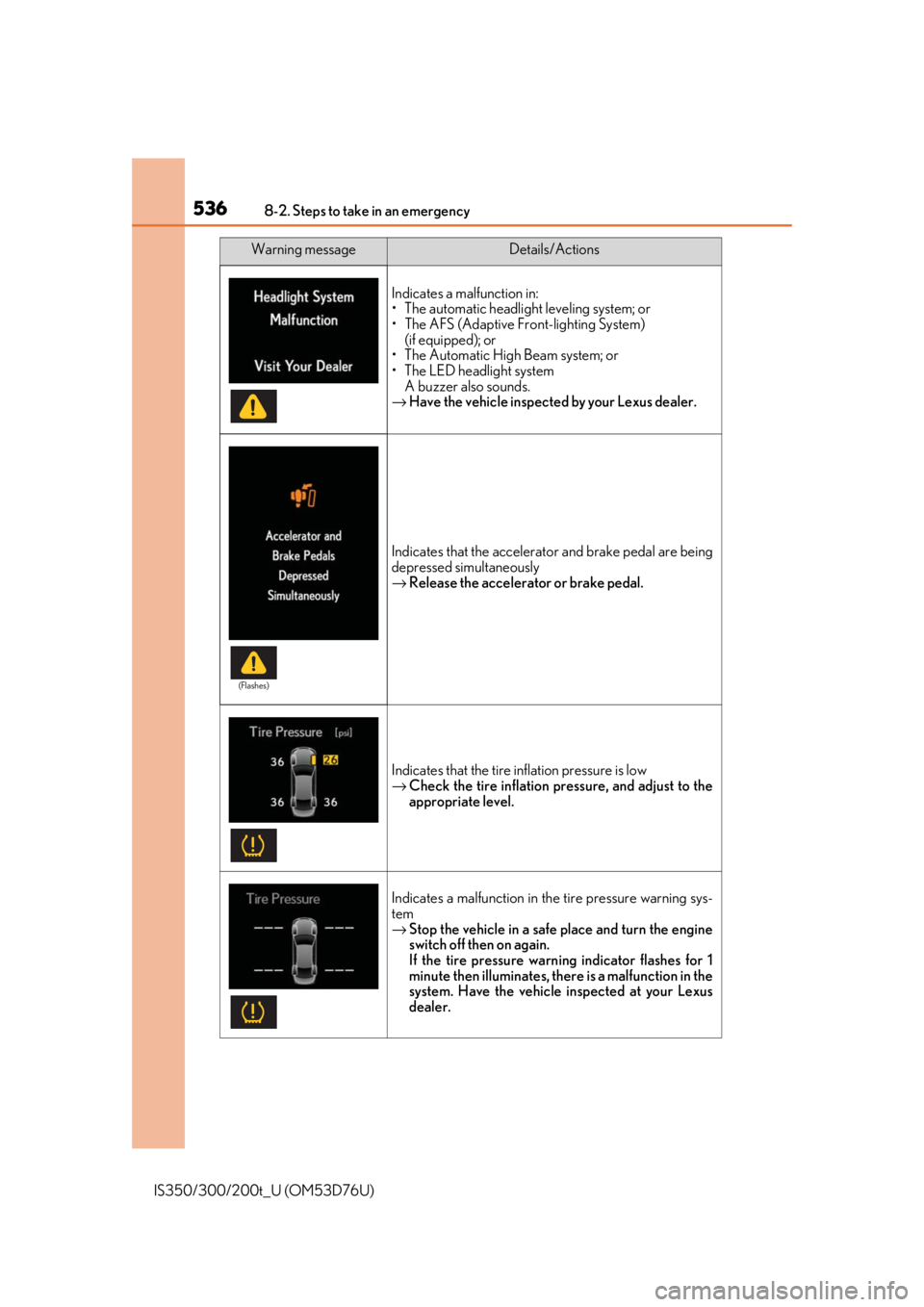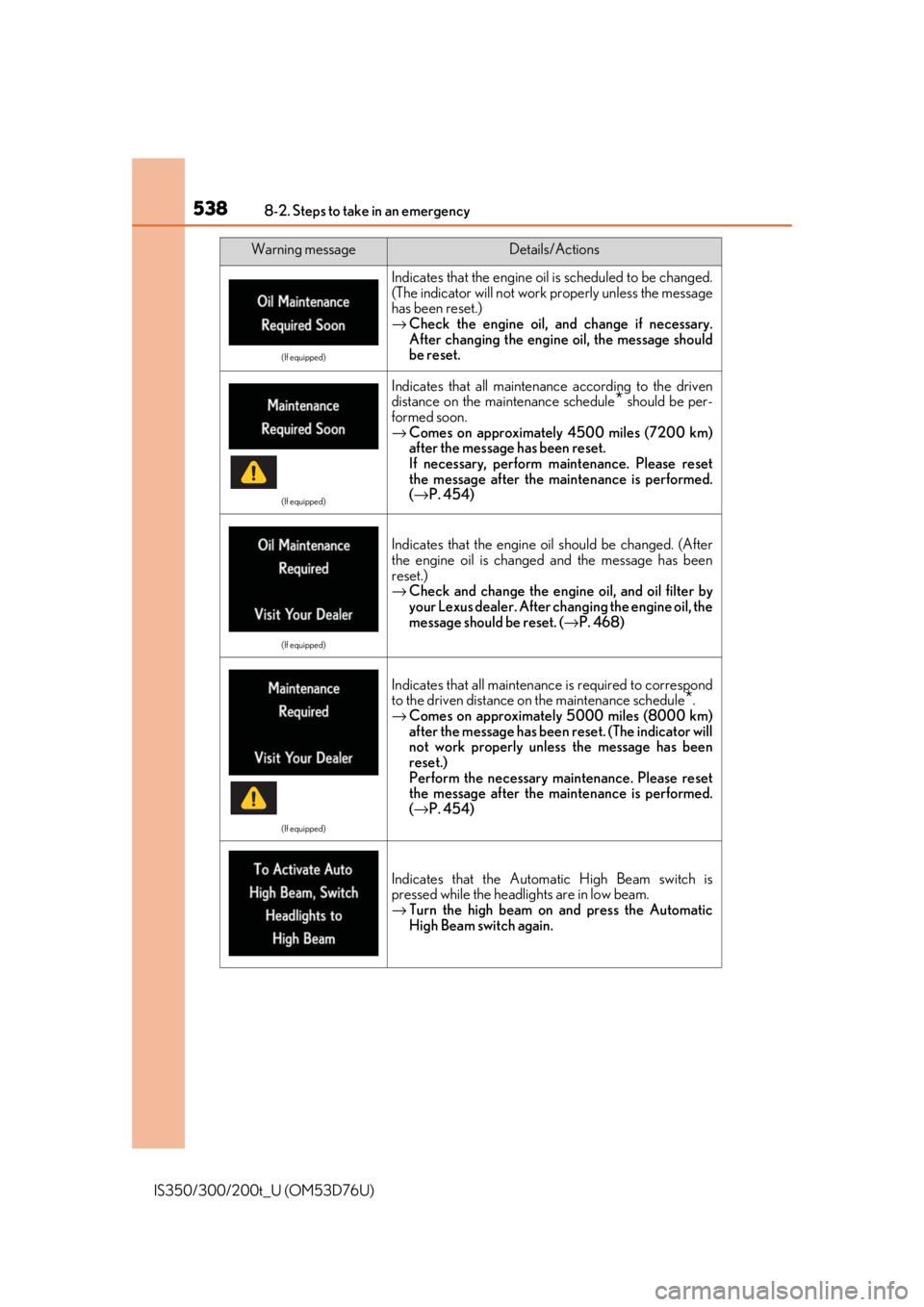low beam Lexus IS350 2017 Owner's Manual / LEXUS 2017 IS200T,IS300,IS350 OWNER'S MANUAL (OM53D76U)
[x] Cancel search | Manufacturer: LEXUS, Model Year: 2017, Model line: IS350, Model: Lexus IS350 2017Pages: 648, PDF Size: 10.73 MB
Page 193 of 648

1934-3. Operating the lights and wipers
4
Driving
IS350/300/200t_U (OM53D76U)
■Switching to the low beams
Pull the lever to its original position.
The Automatic High Beam indicator
will turn off.
Push the lever away from you to acti-
vate the Automatic High Beam sys-
tem again.
■Switching to the high beams
Press the Automatic High Beam
switch.
The Automatic High Beam indicator
will turn off and the high beam indi-
cator will turn on.
Press the switch to activate the Auto-
matic High Beam system again.
Turning the high beams on/off manually
Page 194 of 648

1944-3. Operating the lights and wipers
IS350/300/200t_U (OM53D76U)
■Conditions to turn the high beams on/off automatically
●When all of the following conditions are met, the high beams will be turned on automat-
ically (after approximately 1 second):
• The vehicle speed is approximately 21 mph (34 km/h) or more.
• The area ahead of the vehicle is dark.
• There are no vehicles ahead with headlights or tail lights turned on.
• There are few streetlights on the road ahead.
●If any of the following condit ions is met, the high beams will turn off automatically:
• The vehicle speed is below ap proximately 17 mph (27 km/h).
• The area ahead of the vehicle is not dark.
• Vehicles ahead have th eir headlights or tail lights turned on.
• There are many streetlights on the road ahead.
■Camera sensor detection information
●The high beams may not be automatically turned off in the following situations:
• When a vehicle suddenly appears from around a curve
• When the vehicle is cut in front of by another vehicle
• When vehicles ahead cannot be detected du e to repeated curves, road dividers or
roadside trees
• When vehicles ahead appear in a faraway lane on a wide road
• When the lights of vehicles ahead are not on
●The high beams may be turned off if a vehicl e ahead that is using fog lights without its
headlights turned on is detected.
●House lights, street lights, traffic signals, and illuminated billboards or signs and other
reflective objects may cause the high beams to change to the low beams, or the low
beams to remain on.
●The following factors may affect the amount of time taken for the high beams to turn on
or off:
• The brightness of the headlights, fog lights, and tail lights of vehicles ahead
• The movement and direction of vehicles ahead
• When a vehicle ahead only has operational lights on one side
• When a vehicle ahead is a two-wheeled vehicle
• The condition of the road (gradient, cu rve, condition of the road surface, etc.)
• The number of passengers and amount of luggage in the vehicle
●The high beams may turn on or off unexpectedly.
Page 195 of 648

1954-3. Operating the lights and wipers
4
Driving
IS350/300/200t_U (OM53D76U)
●Bicycles or similar vehicles may not be detected.
●In the following situations the system may not be able to correctly detect the surround-
ing brightness level. This may cause the low beams to remain on or the high beams to
flash or dazzle pedestrians or vehicles ahead. In such a case, it is necessary to manually
switch between the high and low beams.
• When driving in inclement weather (heavy rain, snow, fog, sandstorms, etc.)
• When the windshield is obscured by fog, mist, ice, dirt, etc.
• When the windshield is cracked or damaged
• When the camera sensor is deformed or dirty
• When the temperature of the camera sensor is extremely high
• When the surrounding brightness level is equal to that of headlights, tail lights or fog
lights
• When headlights or tail lights of vehicles ahead are turned off, dirty, changing color,
or not aimed properly
• When the vehicle is hit by water, snow, dust, etc. from a preceding vehicle
• When driving through an area of intermittently changing brightness and darkness
• When frequently and repeated ly driving ascending/descending roads, or roads with
rough, bumpy or uneven surfaces (such as stone-paved roads, gravel roads, etc.)
• When frequently and repeatedly taking curves or driving on a winding road
• When there is a highly reflective object ahea d of the vehicle, such as a sign or mirror
• When the back of a preceding vehicle is highly reflective, such as a container on a
truck
• When the vehicle's headlights are damaged or dirty, or are not aimed properly
• When the vehicle is listing or titling due to a flat tire, a trailer being towed, etc.
• When the headlights are changed between the high beams and low beams repeat- edly in an abnormal manner
• When the driver believes that the high beams may be flashing or dazzling pedestri-
ans or other drivers
■Temporarily lowering sensor sensitivity
The sensitivity of the sensor can be temporarily lowered.
Turn the engine switch off while the following conditions are met.
• The headlight switch is in or .
• The headlight switch lever is in high beam position.
• Automatic High Beam switch is on.
Turn the engine switch to IGNITION ON mode.
Within 30 seconds after , repeat pulling th e headlight switch lever to the original
position then pushing it to the high beam position quickly 10 times, then leave the lever
in high beam position.
If the sensitivity is changed, the Automatic High Beam indicator is turn on and off 3
times.
Automatic High Beam (head lights) may turn on even the vehicle is stopped.
1
2
32
4
Page 207 of 648

207
4
Driving
IS350/300/200t_U (OM53D76U)4-5. Using the driving support systems
◆PCS (Pre-Collision System)
→
P. 214
◆LDA (Lane Departure Alert with steering control)
→P. 227
◆Automatic High Beam
→P. 192
◆Dynamic radar cruise control
→P. 236
Lexus Safety System+
The Lexus Safety System+ consists of the following drive assist systems and
contributes to a safe and comfo rtable driving experience:
WARNING
■Lexus Safety System+
The Lexus Safety System+ is designed to operate under the assumption that the driver
will drive safely, and is designed to help reduce the impact to the occupants and the
vehicle in the case of a collision or assist the driver in normal driving conditions.
As there is a limit to the degree of reco gnition accuracy and control performance that
this system can provide, do not overly rely on this system. The driver is always responsi-
ble for paying attention to the vehicle's surroundings and driving safely.
Page 234 of 648

2344-5. Using the driving support systems
IS350/300/200t_U (OM53D76U)
■Conditions in which functions may not operate properly
In the following situations, the camera sensor may not detect white (yellow) lines and var-
ious functions may not operate normally.
●There are shadows on the road that run parallel with, or cover, the white (yellow) lines.
●The vehicle is driven in an ar ea without white (yellow) lines, such as in front of a tollgate
or checkpoint, or at an intersection, etc.
●The white (yellow) lines are cracked, “Botts ’ dots”, “Raised pavement marker” or stones
are present.
●The white (yellow) lines cannot be seen or are difficult to see due to sand, etc.
●The vehicle is driven on a road surface that is wet due to rain, puddles, etc.
●The traffic lines are yellow (which may be more difficult to recognize than lines that are
white).
●The white (yellow) lines cross over a curb, etc.
●The vehicle is driven on a bright surface, such as concrete.
●The vehicle is driven on a surface that is bright due to reflected light, etc.
●The vehicle is driven in an area where the brightness changes suddenly, such as at the
entrances and exits of tunnels, etc.
●Light from the headlights of an oncoming vehicle, the sun, etc. enters the camera.
●The vehicle is driven where the road diverges, merges, etc.
●The vehicle is driven on a slope.
●The vehicle is driven on a road which tilts left or right, or a winding road.
●The vehicle is driven on an unpaved or rough road.
●The vehicle is driven around a sharp curve.
●The traffic lane is excessively narrow or wide.
●The vehicle is extremely tilted due to carry ing heavy luggage or having improper tire
pressure.
●The distance to the preceding vehicle is extremely short.
●The vehicle is moving up and down a large am ount due to road conditions during driv-
ing (poor roads or road seams).
●The headlight lenses are dirty and emit a faint amount of light at night, or the beam axis
has deviated.
●The vehicle is struck by a crosswind.
●The vehicle has just changed lane s or crossed an intersection.
●Snow tires, etc. are equipped.
Page 531 of 648

5318-2. Steps to take in an emergency
8
When trouble arises
IS350/300/200t_U (OM53D76U)
Indicates a malfunction in the LDA (Lane Departure
Alert with steering control) systemA buzzer also sounds.
→ Have the vehicle inspected by your Lexus dealer.
The operation conditions of the camera sensor (tem-
perature, etc.) are not met.
→When the operation conditions of the camera sen-
sor (temperature, etc.) are met, the following sys-
tems will become available.
• PCS (Pre-Collision System)
• LDA (Lane Departure Alert with steering control) system
•Automatic High Beam
Indicates that the system is temporarily unavailable due
to a malfunction in a sensor other than the camera sen-
sor
A buzzer also sounds.
→ Turn the LDA (Lane Departure Alert with steering
control) system off, wait for a little while, and then
turn the LDA (Lane Depart ure Alert with steering
control) system back on.
Dirt, rain, condensation, ice, snow, etc., are present on
the windshield in front of the camera sensor. The following systems will be temporarily unusable.
• PCS (Pre-Collision System)
• LDA (Lane Departure Alert with steering control) system
•Automatic High Beam
→ Turn the system off, remove any dirt, rain, condensa-
tion, ice, snow, etc., from the windshield, and then
turn the system back on.
Warning messageDetails/Actions
(Flashes)
(Flashes)
Page 536 of 648

5368-2. Steps to take in an emergency
IS350/300/200t_U (OM53D76U)
Indicates a malfunction in:
• The automatic headlight leveling system; or
• The AFS (Adaptive Front-lighting System) (if equipped); or
• The Automatic High Beam system; or
• The LED headlight system
A buzzer also sounds.
→ Have the vehicle inspected by your Lexus dealer.
Indicates that the accelerato r and brake pedal are being
depressed simultaneously
→ Release the accelerator or brake pedal.
Indicates that the tire in flation pressure is low
→ Check the tire inflation pressure, and adjust to the
appropriate level.
Indicates a malfunction in the tire pressure warning sys-
tem
→Stop the vehicle in a safe place and turn the engine
switch off then on again.
If the tire pressure warn ing indicator flashes for 1
minute then illuminates, ther e is a malfunction in the
system. Have the vehicle inspected at your Lexus
dealer.
Warning messageDetails/Actions
(Flashes)
Page 538 of 648

5388-2. Steps to take in an emergency
IS350/300/200t_U (OM53D76U)
(If equipped)
Indicates that the engine oil is scheduled to be changed.
(The indicator will not work properly unless the message
has been reset.)
→Check the engine oil, and change if necessary.
After changing the engine oil, the message should
be reset.
(If equipped)
Indicates that all maintenance according to the driven
distance on the maintenance schedule* should be per-
formed soon.
→ Comes on approximately 4500 miles (7200 km)
after the message has been reset.
If necessary, perform maintenance. Please reset
the message after the maintenance is performed.
(→ P. 454)
(If equipped)
Indicates that the engine oil should be changed. (After
the engine oil is changed and the message has been
reset.)
→ Check and change the engine oil, and oil filter by
your Lexus dealer. After chan ging the engine oil, the
message should be reset. ( →P. 468)
(If equipped)
Indicates that all maintenanc e is required to correspond
to the driven distance on the maintenance schedule
*.
→ Comes on approximately 5000 miles (8000 km)
after the message has been reset. (The indicator will
not work properly unless the message has been
reset.)
Perform the necessary maintenance. Please reset
the message after the maintenance is performed.
(→ P. 454)
Indicates that the Automatic High Beam switch is
pressed while the headlights are in low beam.
→ Turn the high beam on and press the Automatic
High Beam switch again.
Warning messageDetails/Actions